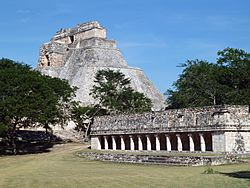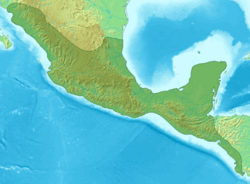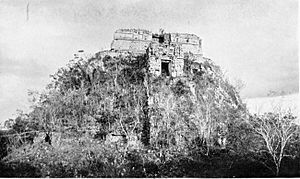Pyramid of the Magician facts for kids
 |
|
| Alternative name | Pyramid of the Dwarf, Pirámide del adivino, Pyramid of the Soothsayer |
|---|---|
| Location | Yucatan |
| Region | Uxmal |
| Coordinates | 20°21′34″N 89°46′17″W / 20.35944°N 89.77139°W |
| Type | Temple |
| Width | 81 m (266 ft) |
| Height | 40 m (131 ft) |
| History | |
| Builder | Unknown; Itzamna or his mother (Mythical) |
| Material | Limestone |
| Founded | 560 |
| Periods | 560–16th century |
| Cultures | Maya |
| Site notes | |
| Condition | Abandoned |
The Pyramid of the Magician (Spanish: Pirámide del adivino) is a tall, ancient pyramid found in the Mayan city of Uxmal, Mexico. It is the most famous and tallest building in Uxmal.
Contents
Exploring the Pyramid of the Magician
The Pyramid of the Magician is the main building in the ancient city of Uxmal. Uxmal is located in the Puuc region of Mexico. It was once one of the biggest cities on the Yucatán Peninsula. At its busiest, about 25,000 people lived there. Like other cities in the Puuc region, Uxmal was very successful from 600 to 1000 AD. Most of its great buildings were constructed between 700 and 1000 AD. The name Uxmal means 'thrice-built' in the Mayan language. This refers to how its biggest pyramid was built in many layers over time.
In 1996, the city of Uxmal became a UNESCO World Heritage Site. This means it is a very important place that needs to be protected. The ruins of Uxmal's ceremonial buildings show the best of late Maya art and architecture. The Pyramid of the Magician stands in the middle of the complex. It is at the entrance to the main courtyard. Its western side faces the setting sun during the summer solstice.
How the Pyramid Was Built and Found
Building the first temple of the pyramid started in the 6th century AD. The structure was made bigger over the next 400 years. After 1000 AD, the pyramid started to fall apart. It was also looted during the Spanish Conquest of Yucatán.
Jean-Frederic Waldeck wrote the first detailed report about the ruins in 1838. His report inspired John Lloyd Stephens and his artist friend, Frederick Catherwood. They visited the site twice between 1839 and 1841. They drew and recorded the complex. Stephens then published his famous book, Incidents of Travel in the Yucatan.
Work to restore the buildings in Uxmal began in the mid-1800s. The Pyramid of the Magician was regularly repaired during this time. In the early 1970s, a big project was started by archaeologists from the National Institute of Anthropology and History (INAH). Their goal was to make the pyramid's sides and terraces stronger. They also wanted to improve the temples' structure.
In 1988, Hurricane Gilbert hit the Yucatán Peninsula. It brought strong winds and heavy rain. This caused a lot of damage to the outside of the pyramid. After the hurricane, experts found cracks in the walls on the south side. They also saw damage to the walls at the pyramid's base on the west side.
Archaeologists and experts from INAH quickly started to plan how to fix and protect the pyramid. They decided to strengthen the west side and watch for any more changes. They filled a hole under the stairway with stone and plaster. They also placed monitors to detect any movement. These steps stopped the pyramid from collapsing. However, in late 1997, more small cracks appeared. Work to protect the pyramid is still ongoing. Like El Castillo in Chichen Itza, visitors are now not allowed to climb the Pyramid of the Magician.
Pyramid's Shape and Building Stages
How Big is the Pyramid?
The exact height of the Pyramid of the Magician is not fully agreed upon. Some say it is 40 meters (131 feet) tall, while others say it is 27.6 meters (90.5 feet). Most experts agree it is about 35 meters (115 feet) tall. Its base is about 69 by 49 meters (227 by 162 feet). Even with different measurements, it is still the tallest building in Uxmal.
The Pyramid of the Magician is very special among Mayan buildings in the Yucatán. It stands out because of its rounded sides, great height, steep slope, and unusual oval base.
Building Over Time: The Five Temples
The pyramid was built in several stages over three centuries. This happened during the Terminal Classic Period. Experts believe construction started in the 6th century and continued until the 10th century. The Mayans often built new structures on top of older ones. This is called superimposition. The pyramid you see today is actually five temples built one on top of the other.
- Temple I is the oldest part. You can see it at the base of the pyramid on the west side. It was built around the 6th century AD. This is known from a date carved on a door frame and from radiocarbon dating. This part of the temple is decorated with masks of the god Chaac. This style is called Chenes architecture. The path to this temple was closed after Hurricane Gilbert in 1988 to protect it.
- Temple II can be reached through an opening in the upper part of the eastern staircase. This temple has not been fully dug out. Its main room has columns supporting the roof.
- Temple III is built behind Temple II and cannot be seen from the outside. It has a small central shrine and a room before it.
- Temple IV is entered from the west side and has the most detailed decorations. It is built in the Chenes style. The temple's front looks like a giant mask of Chaac, with the doorway as its mouth. The entire front of this temple is covered with masks of the rain god and other patterns.
- Temple V, also known as The House of the Magician or Soothsayer, is the last part of the pyramid to be built. This temple sits on top of the pyramid and dates from the 9th century. Temple V has three rooms and also features patterned decorations.
There are two steep staircases (about 60° angle) that lead to the top of the pyramid.
- The Eastern Stairs are wider and go from the base to the top temple. Near the top, there is a smaller temple built into the stairway itself.
- The Western Stairs face the Nunnery Quadrangle. They are much more decorated than the eastern side. Along both sides of this narrower staircase, you can see images of the rain god Chaac. As people climbed these stairs, it was like climbing the "Stairways of the Gods" towards a special altar.
Building Styles: Puuc and Chenes
The early parts of the Pyramid of the Magician were built in the Puuc style. This style often has plain lower parts and very decorated upper parts. Early Puuc buildings had roof crests and slanted decorations. Later Puuc styles used limestone with smooth walls. They also used plaster finishes and many masks of the rain god Chaac.
Chenes design was popular in later Mayan building. It is known for doorways that look like the mouth of a large creature mask. The front of Chenes buildings often has three parts. These parts might stick out or go back from the rest of the building. The rooms are usually decorated with Chaac masks. You can see Chenes features in the upper temples of the pyramid.
Visiting the Pyramid Today
The Pyramid of the Magician is still the main attraction at the Uxmal site. Today, you can find modern facilities at the entrance, right in front of the pyramid. These include a cafeteria, a souvenir shop, and restrooms. There is also a small museum and an auditorium. The site is open from 8 AM to 5 PM. Every evening, there is a sound and light show in both English and Spanish. The Pyramid of the Magician is the main focus of this show.
The Legend of the Magician
The pyramid gets its name from old stories told by the local Maya people. No one knows how old these tales are, or what the pyramid was called before the Spanish arrived. There are different versions of the story about how the Pyramid of the Magician was built.
One story says that a magician-god named Itzamna built the pyramid all by himself in just one night, using his great power and magic.
Another tale says that a special gong would sound, and when it did, the city of Uxmal would be ruled by a boy "not born of woman." One day, a dwarf struck the gong. This dwarf was not born from a mother but hatched from an egg by an old woman who had no children. The sound of the gong scared the city's ruler, who ordered the dwarf to be killed. However, the ruler changed his mind. He promised to spare the dwarf's life if he could complete three impossible tasks. One of these tasks was to build a huge pyramid, taller than any other building in the city, in a single night. The dwarf managed to complete all the tasks, including building the pyramid. The dwarf was then celebrated as the new ruler of Uxmal, and the pyramid was named after him.
A slightly different version of this story was told to John Lloyd Stephens in 1840 by a local Maya person:
There was an old witch who lived in a hut where the pyramid now stands. She was sad because she had no children. One day, she took an egg, wrapped it in cloth, and put it in her hut. Every day she checked on the egg. One day, it hatched, and a tiny creature, like a baby, came out.
The old woman was very happy and called the baby her son. She took good care of him, and within a year, he was walking and talking like a man. But he stopped growing after a year. The old woman was very proud and told him he would one day be a great Lord or King.
One day, she told her son to go to the House of the Governor and challenge the King to a test of strength. The dwarf did not want to go at first, but his mother insisted. So, he went to see the King. The guards let him in, and he gave his challenge to the King. The King smiled and told the dwarf to lift a stone that weighed 34 kg (75 pounds). The dwarf cried and ran back to his mother. The wise witch told her son to tell the King that if the King lifted the stone first, then the dwarf would lift it too. The dwarf returned and told the King. The King lifted the stone, and the dwarf did the same. The King was impressed and a little worried. He tested the dwarf all day with other strength challenges. Each time the King did something, the dwarf could do it too.
The King became very angry that a dwarf could match him. He told the dwarf that he must build a house taller than any other in the city in one night, or he would be killed. The dwarf again ran crying to his mother. She told him not to worry and to go straight to bed. The next morning, the city woke up to see the Pyramid of the Dwarf finished, taller than any other building in the city.
The King saw this building from his palace and was furious again. He called the dwarf and ordered one final test of strength. The dwarf had to collect two bundles of Cogoil wood, which is very strong and heavy. The King would break the wood over the dwarf’s head, and then the dwarf would have his turn to break the wood over the King's head.
The dwarf again ran to his mother for help. She told him not to worry and placed a magical tortilla on his head for protection. The test was to happen in front of all the important men of the city. The King broke his entire bundle of wood over the dwarf’s head, one stick at a time. The King could not hurt the dwarf. He then tried to back out of the challenge. But with all the town's important men watching, he knew he had no choice.
The second stick from the dwarf’s bundle broke the King's skull into pieces, and he fell dead at the dwarf's feet. The dwarf was then hailed as the new King.
See also
 In Spanish: Pirámide del adivino para niños
In Spanish: Pirámide del adivino para niños



